BSBWHS501 & BSBSUS501 Assignment: Safety and Sustainability
VerifiedAdded on 2022/08/16
|27
|4162
|13
Homework Assignment
AI Summary
This document provides a comprehensive solution to a student assignment covering BSBWHS501 (Ensure a Safe Workplace) and BSBSUS501 (Develop Workplace Policy and Procedures for Sustainability). The assignment addresses key aspects of workplace health and safety (WHS) in Australia, including relevant legislation (Occupational Health and Safety Act 2004, Work Health and Safety Regulations 2011), risk management, hazard identification, compliance codes, and the duties of employers and workers. It also explores the development of WHS policies, training, and the roles of various stakeholders. Furthermore, the assignment delves into sustainability, covering the development and implementation of workplace sustainability policies, methods to minimize resource use, management of hazardous materials, and the integration of sustainability into business operations. The solution includes answers to specific questions, case study analysis, and policy development scenarios, providing a thorough understanding of both WHS and sustainability principles in a workplace context.
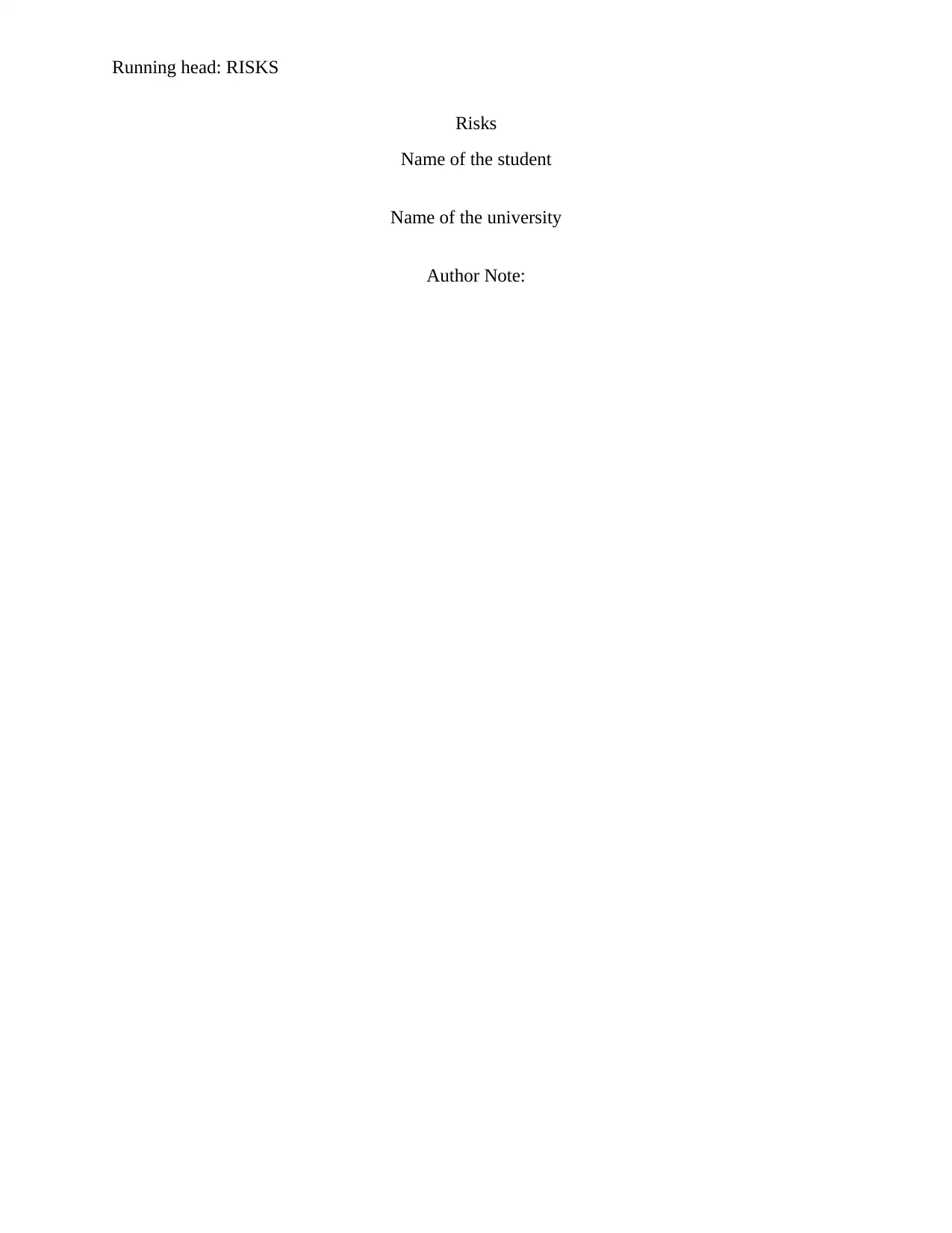
Running head: RISKS
Risks
Name of the student
Name of the university
Author Note:
Risks
Name of the student
Name of the university
Author Note:
Paraphrase This Document
Need a fresh take? Get an instant paraphrase of this document with our AI Paraphraser
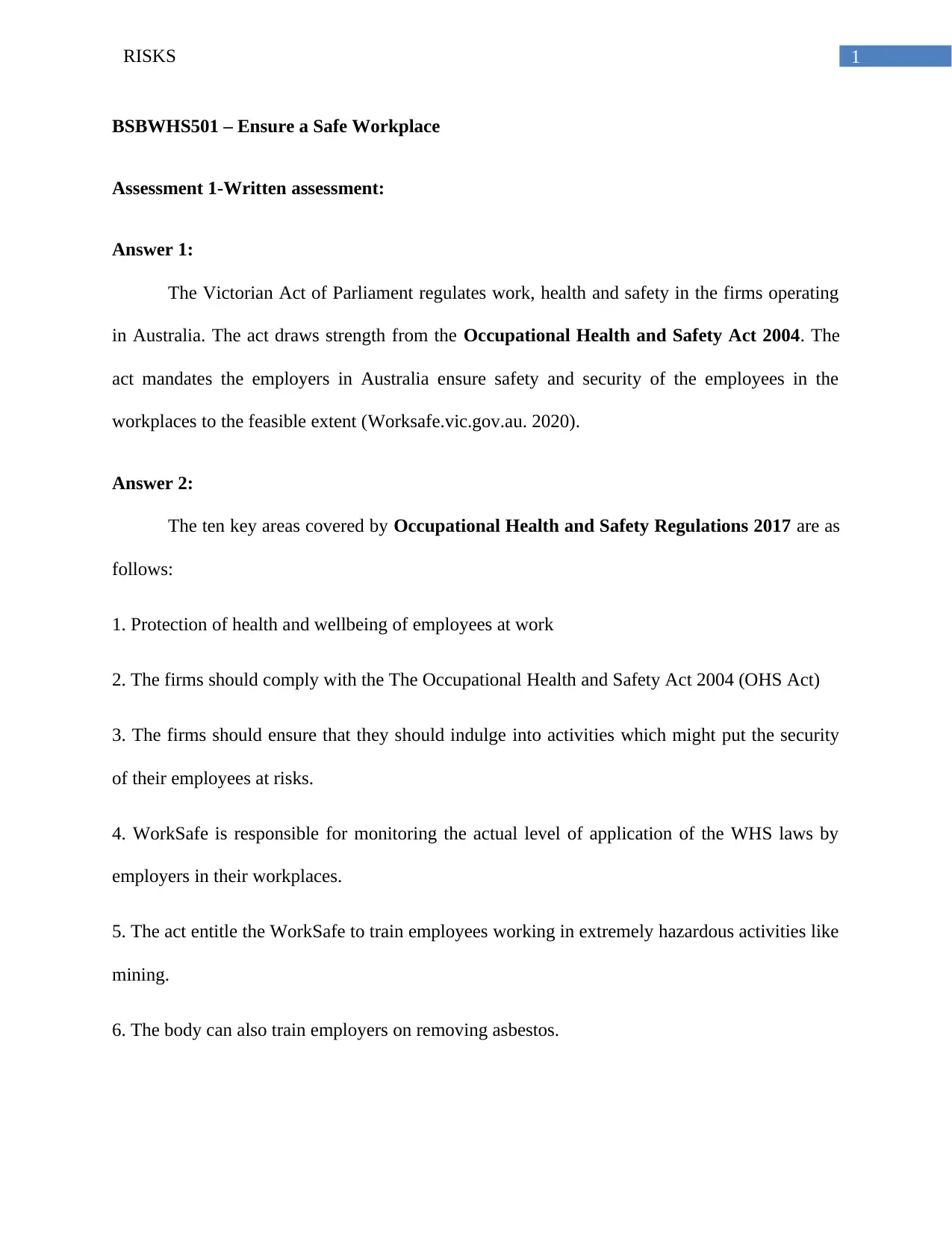
1RISKS
BSBWHS501 – Ensure a Safe Workplace
Assessment 1-Written assessment:
Answer 1:
The Victorian Act of Parliament regulates work, health and safety in the firms operating
in Australia. The act draws strength from the Occupational Health and Safety Act 2004. The
act mandates the employers in Australia ensure safety and security of the employees in the
workplaces to the feasible extent (Worksafe.vic.gov.au. 2020).
Answer 2:
The ten key areas covered by Occupational Health and Safety Regulations 2017 are as
follows:
1. Protection of health and wellbeing of employees at work
2. The firms should comply with the The Occupational Health and Safety Act 2004 (OHS Act)
3. The firms should ensure that they should indulge into activities which might put the security
of their employees at risks.
4. WorkSafe is responsible for monitoring the actual level of application of the WHS laws by
employers in their workplaces.
5. The act entitle the WorkSafe to train employees working in extremely hazardous activities like
mining.
6. The body can also train employers on removing asbestos.
BSBWHS501 – Ensure a Safe Workplace
Assessment 1-Written assessment:
Answer 1:
The Victorian Act of Parliament regulates work, health and safety in the firms operating
in Australia. The act draws strength from the Occupational Health and Safety Act 2004. The
act mandates the employers in Australia ensure safety and security of the employees in the
workplaces to the feasible extent (Worksafe.vic.gov.au. 2020).
Answer 2:
The ten key areas covered by Occupational Health and Safety Regulations 2017 are as
follows:
1. Protection of health and wellbeing of employees at work
2. The firms should comply with the The Occupational Health and Safety Act 2004 (OHS Act)
3. The firms should ensure that they should indulge into activities which might put the security
of their employees at risks.
4. WorkSafe is responsible for monitoring the actual level of application of the WHS laws by
employers in their workplaces.
5. The act entitle the WorkSafe to train employees working in extremely hazardous activities like
mining.
6. The body can also train employers on removing asbestos.
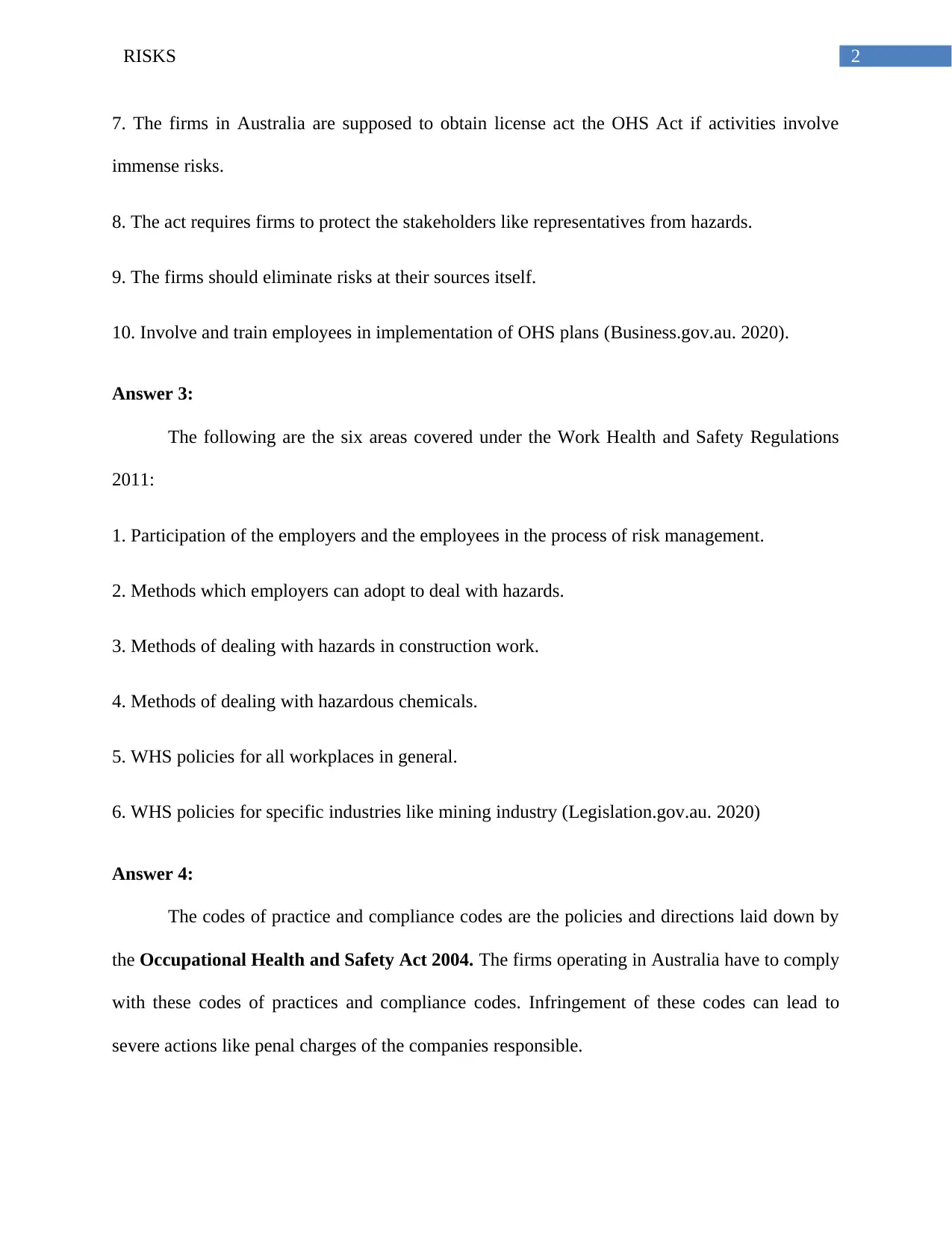
2RISKS
7. The firms in Australia are supposed to obtain license act the OHS Act if activities involve
immense risks.
8. The act requires firms to protect the stakeholders like representatives from hazards.
9. The firms should eliminate risks at their sources itself.
10. Involve and train employees in implementation of OHS plans (Business.gov.au. 2020).
Answer 3:
The following are the six areas covered under the Work Health and Safety Regulations
2011:
1. Participation of the employers and the employees in the process of risk management.
2. Methods which employers can adopt to deal with hazards.
3. Methods of dealing with hazards in construction work.
4. Methods of dealing with hazardous chemicals.
5. WHS policies for all workplaces in general.
6. WHS policies for specific industries like mining industry (Legislation.gov.au. 2020)
Answer 4:
The codes of practice and compliance codes are the policies and directions laid down by
the Occupational Health and Safety Act 2004. The firms operating in Australia have to comply
with these codes of practices and compliance codes. Infringement of these codes can lead to
severe actions like penal charges of the companies responsible.
7. The firms in Australia are supposed to obtain license act the OHS Act if activities involve
immense risks.
8. The act requires firms to protect the stakeholders like representatives from hazards.
9. The firms should eliminate risks at their sources itself.
10. Involve and train employees in implementation of OHS plans (Business.gov.au. 2020).
Answer 3:
The following are the six areas covered under the Work Health and Safety Regulations
2011:
1. Participation of the employers and the employees in the process of risk management.
2. Methods which employers can adopt to deal with hazards.
3. Methods of dealing with hazards in construction work.
4. Methods of dealing with hazardous chemicals.
5. WHS policies for all workplaces in general.
6. WHS policies for specific industries like mining industry (Legislation.gov.au. 2020)
Answer 4:
The codes of practice and compliance codes are the policies and directions laid down by
the Occupational Health and Safety Act 2004. The firms operating in Australia have to comply
with these codes of practices and compliance codes. Infringement of these codes can lead to
severe actions like penal charges of the companies responsible.
⊘ This is a preview!⊘
Do you want full access?
Subscribe today to unlock all pages.

Trusted by 1+ million students worldwide
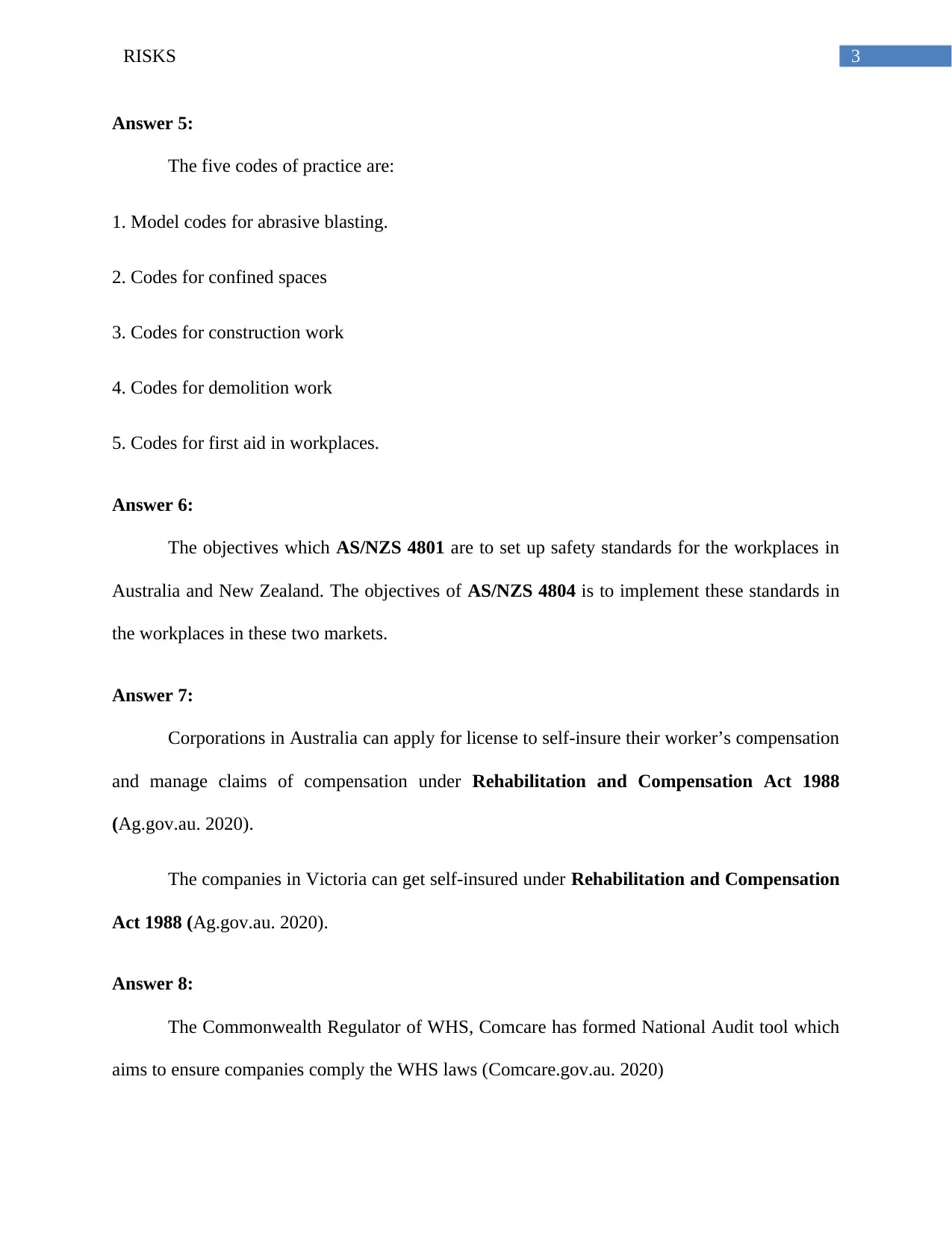
3RISKS
Answer 5:
The five codes of practice are:
1. Model codes for abrasive blasting.
2. Codes for confined spaces
3. Codes for construction work
4. Codes for demolition work
5. Codes for first aid in workplaces.
Answer 6:
The objectives which AS/NZS 4801 are to set up safety standards for the workplaces in
Australia and New Zealand. The objectives of AS/NZS 4804 is to implement these standards in
the workplaces in these two markets.
Answer 7:
Corporations in Australia can apply for license to self-insure their worker’s compensation
and manage claims of compensation under Rehabilitation and Compensation Act 1988
(Ag.gov.au. 2020).
The companies in Victoria can get self-insured under Rehabilitation and Compensation
Act 1988 (Ag.gov.au. 2020).
Answer 8:
The Commonwealth Regulator of WHS, Comcare has formed National Audit tool which
aims to ensure companies comply the WHS laws (Comcare.gov.au. 2020)
Answer 5:
The five codes of practice are:
1. Model codes for abrasive blasting.
2. Codes for confined spaces
3. Codes for construction work
4. Codes for demolition work
5. Codes for first aid in workplaces.
Answer 6:
The objectives which AS/NZS 4801 are to set up safety standards for the workplaces in
Australia and New Zealand. The objectives of AS/NZS 4804 is to implement these standards in
the workplaces in these two markets.
Answer 7:
Corporations in Australia can apply for license to self-insure their worker’s compensation
and manage claims of compensation under Rehabilitation and Compensation Act 1988
(Ag.gov.au. 2020).
The companies in Victoria can get self-insured under Rehabilitation and Compensation
Act 1988 (Ag.gov.au. 2020).
Answer 8:
The Commonwealth Regulator of WHS, Comcare has formed National Audit tool which
aims to ensure companies comply the WHS laws (Comcare.gov.au. 2020)
Paraphrase This Document
Need a fresh take? Get an instant paraphrase of this document with our AI Paraphraser
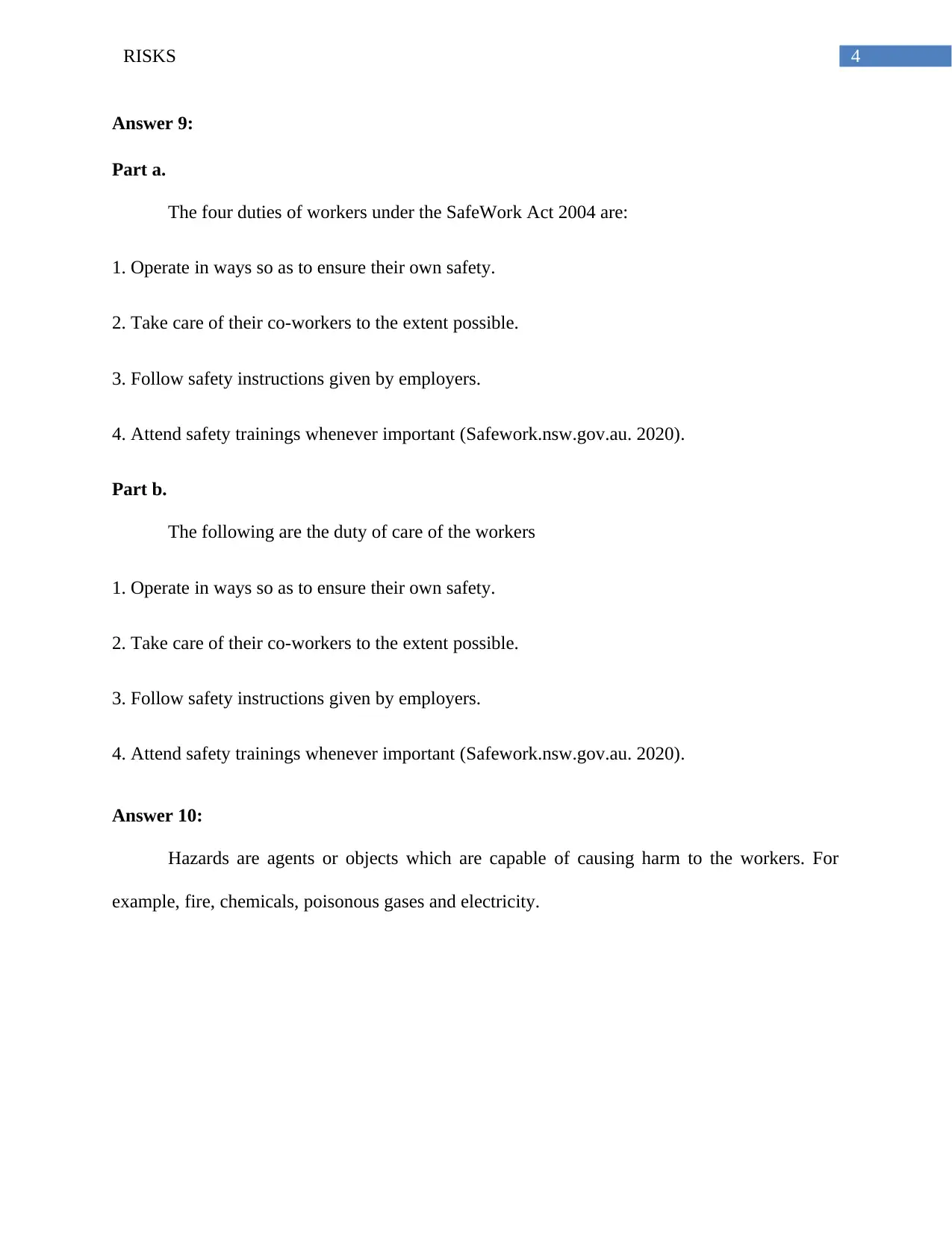
4RISKS
Answer 9:
Part a.
The four duties of workers under the SafeWork Act 2004 are:
1. Operate in ways so as to ensure their own safety.
2. Take care of their co-workers to the extent possible.
3. Follow safety instructions given by employers.
4. Attend safety trainings whenever important (Safework.nsw.gov.au. 2020).
Part b.
The following are the duty of care of the workers
1. Operate in ways so as to ensure their own safety.
2. Take care of their co-workers to the extent possible.
3. Follow safety instructions given by employers.
4. Attend safety trainings whenever important (Safework.nsw.gov.au. 2020).
Answer 10:
Hazards are agents or objects which are capable of causing harm to the workers. For
example, fire, chemicals, poisonous gases and electricity.
Answer 9:
Part a.
The four duties of workers under the SafeWork Act 2004 are:
1. Operate in ways so as to ensure their own safety.
2. Take care of their co-workers to the extent possible.
3. Follow safety instructions given by employers.
4. Attend safety trainings whenever important (Safework.nsw.gov.au. 2020).
Part b.
The following are the duty of care of the workers
1. Operate in ways so as to ensure their own safety.
2. Take care of their co-workers to the extent possible.
3. Follow safety instructions given by employers.
4. Attend safety trainings whenever important (Safework.nsw.gov.au. 2020).
Answer 10:
Hazards are agents or objects which are capable of causing harm to the workers. For
example, fire, chemicals, poisonous gases and electricity.
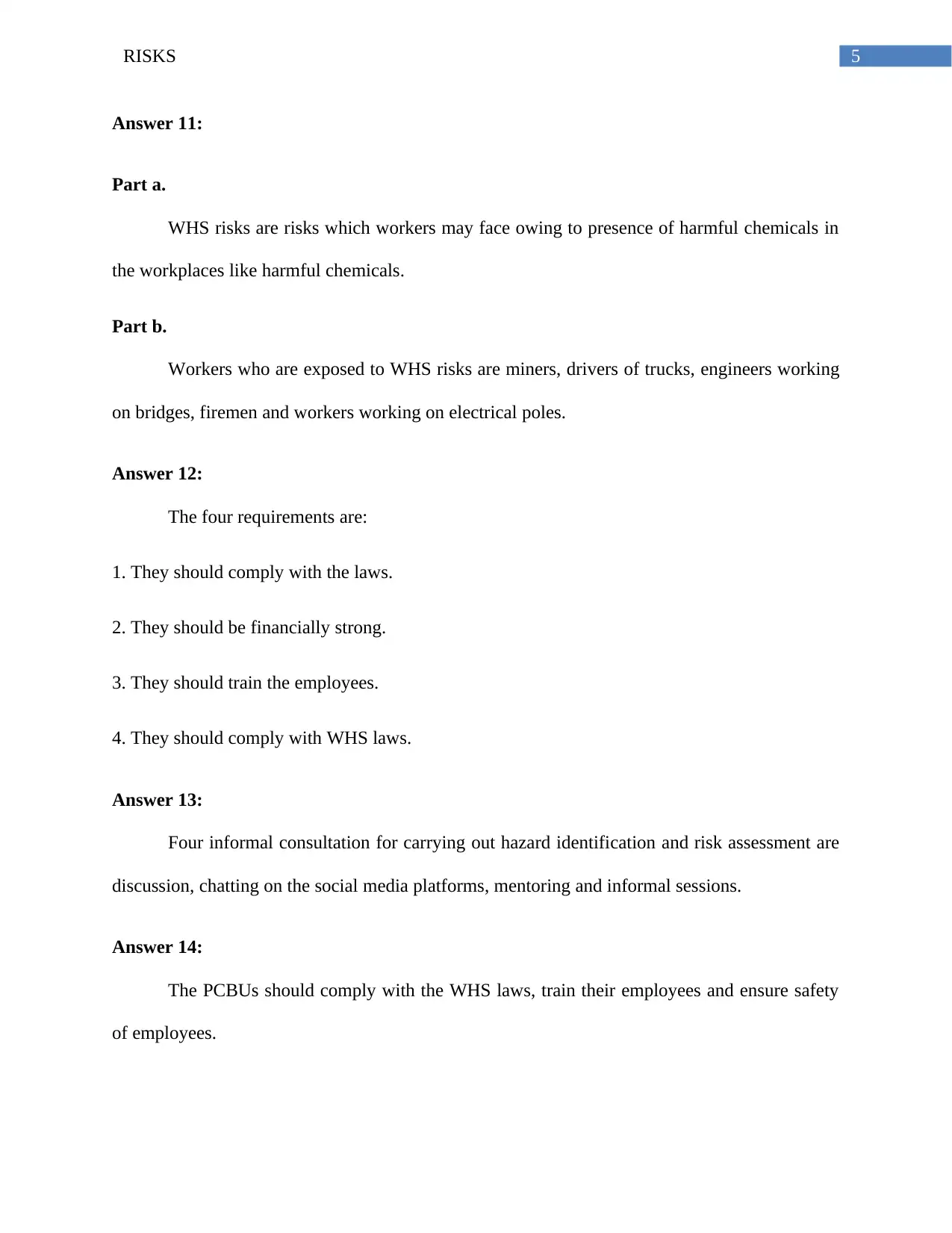
5RISKS
Answer 11:
Part a.
WHS risks are risks which workers may face owing to presence of harmful chemicals in
the workplaces like harmful chemicals.
Part b.
Workers who are exposed to WHS risks are miners, drivers of trucks, engineers working
on bridges, firemen and workers working on electrical poles.
Answer 12:
The four requirements are:
1. They should comply with the laws.
2. They should be financially strong.
3. They should train the employees.
4. They should comply with WHS laws.
Answer 13:
Four informal consultation for carrying out hazard identification and risk assessment are
discussion, chatting on the social media platforms, mentoring and informal sessions.
Answer 14:
The PCBUs should comply with the WHS laws, train their employees and ensure safety
of employees.
Answer 11:
Part a.
WHS risks are risks which workers may face owing to presence of harmful chemicals in
the workplaces like harmful chemicals.
Part b.
Workers who are exposed to WHS risks are miners, drivers of trucks, engineers working
on bridges, firemen and workers working on electrical poles.
Answer 12:
The four requirements are:
1. They should comply with the laws.
2. They should be financially strong.
3. They should train the employees.
4. They should comply with WHS laws.
Answer 13:
Four informal consultation for carrying out hazard identification and risk assessment are
discussion, chatting on the social media platforms, mentoring and informal sessions.
Answer 14:
The PCBUs should comply with the WHS laws, train their employees and ensure safety
of employees.
⊘ This is a preview!⊘
Do you want full access?
Subscribe today to unlock all pages.

Trusted by 1+ million students worldwide
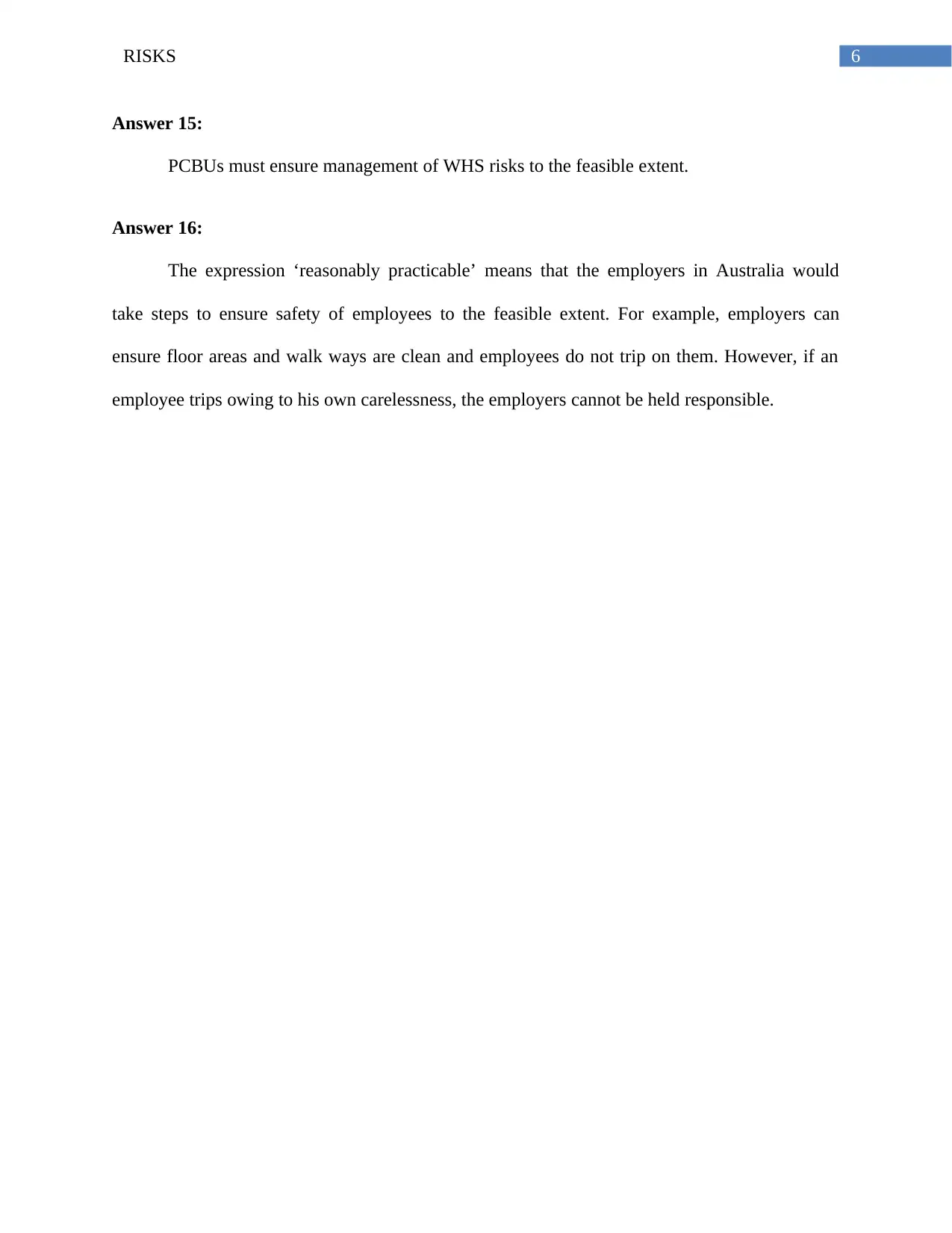
6RISKS
Answer 15:
PCBUs must ensure management of WHS risks to the feasible extent.
Answer 16:
The expression ‘reasonably practicable’ means that the employers in Australia would
take steps to ensure safety of employees to the feasible extent. For example, employers can
ensure floor areas and walk ways are clean and employees do not trip on them. However, if an
employee trips owing to his own carelessness, the employers cannot be held responsible.
Answer 15:
PCBUs must ensure management of WHS risks to the feasible extent.
Answer 16:
The expression ‘reasonably practicable’ means that the employers in Australia would
take steps to ensure safety of employees to the feasible extent. For example, employers can
ensure floor areas and walk ways are clean and employees do not trip on them. However, if an
employee trips owing to his own carelessness, the employers cannot be held responsible.
Paraphrase This Document
Need a fresh take? Get an instant paraphrase of this document with our AI Paraphraser
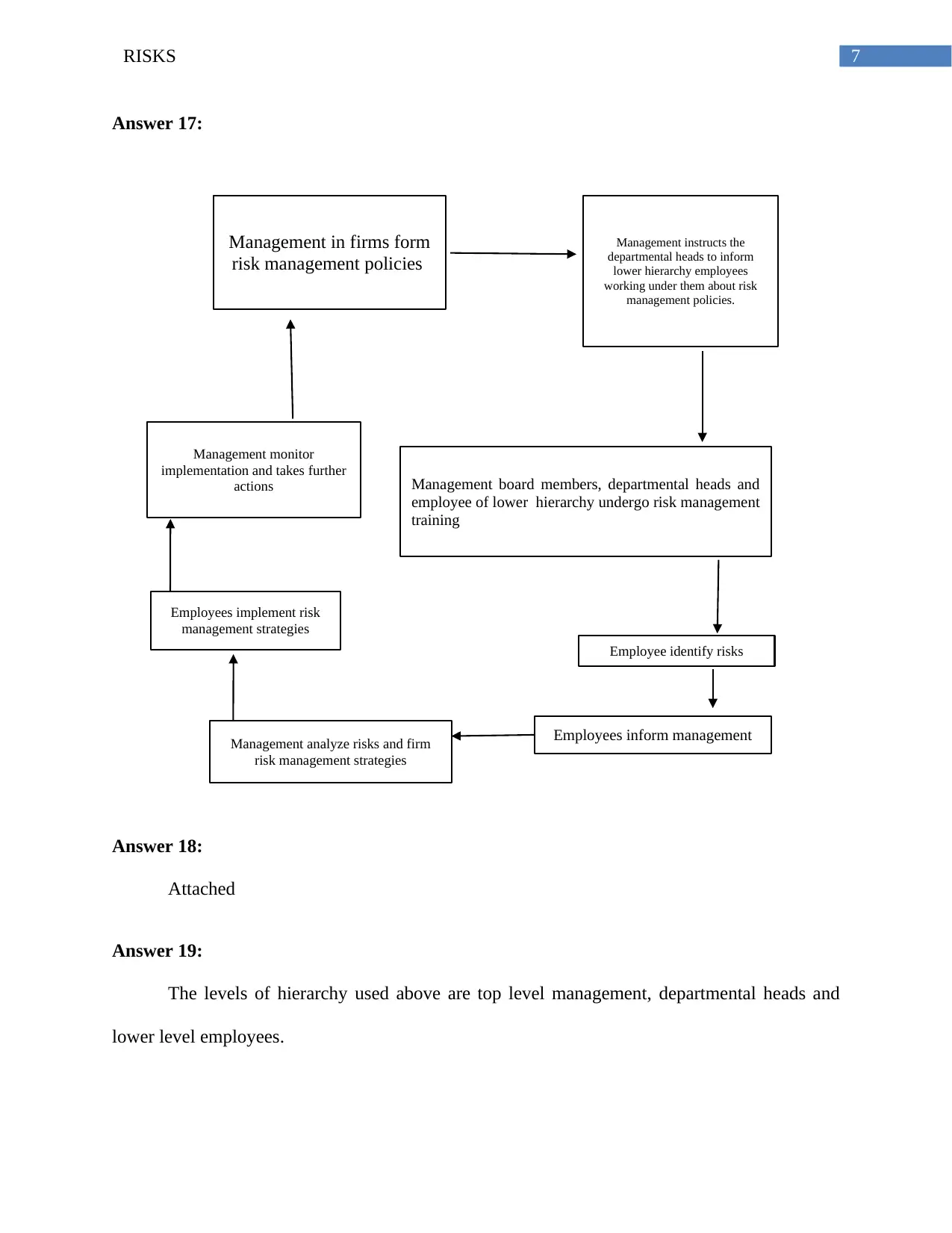
7RISKS
Management in firms form
risk management policies
Management instructs the
departmental heads to inform
lower hierarchy employees
working under them about risk
management policies.
Management board members, departmental heads and
employee of lower hierarchy undergo risk management
training
Employee identify risks
Employees inform management
Management analyze risks and firm
risk management strategies
Employees implement risk
management strategies
Management monitor
implementation and takes further
actions
Answer 17:
Answer 18:
Attached
Answer 19:
The levels of hierarchy used above are top level management, departmental heads and
lower level employees.
Management in firms form
risk management policies
Management instructs the
departmental heads to inform
lower hierarchy employees
working under them about risk
management policies.
Management board members, departmental heads and
employee of lower hierarchy undergo risk management
training
Employee identify risks
Employees inform management
Management analyze risks and firm
risk management strategies
Employees implement risk
management strategies
Management monitor
implementation and takes further
actions
Answer 17:
Answer 18:
Attached
Answer 19:
The levels of hierarchy used above are top level management, departmental heads and
lower level employees.
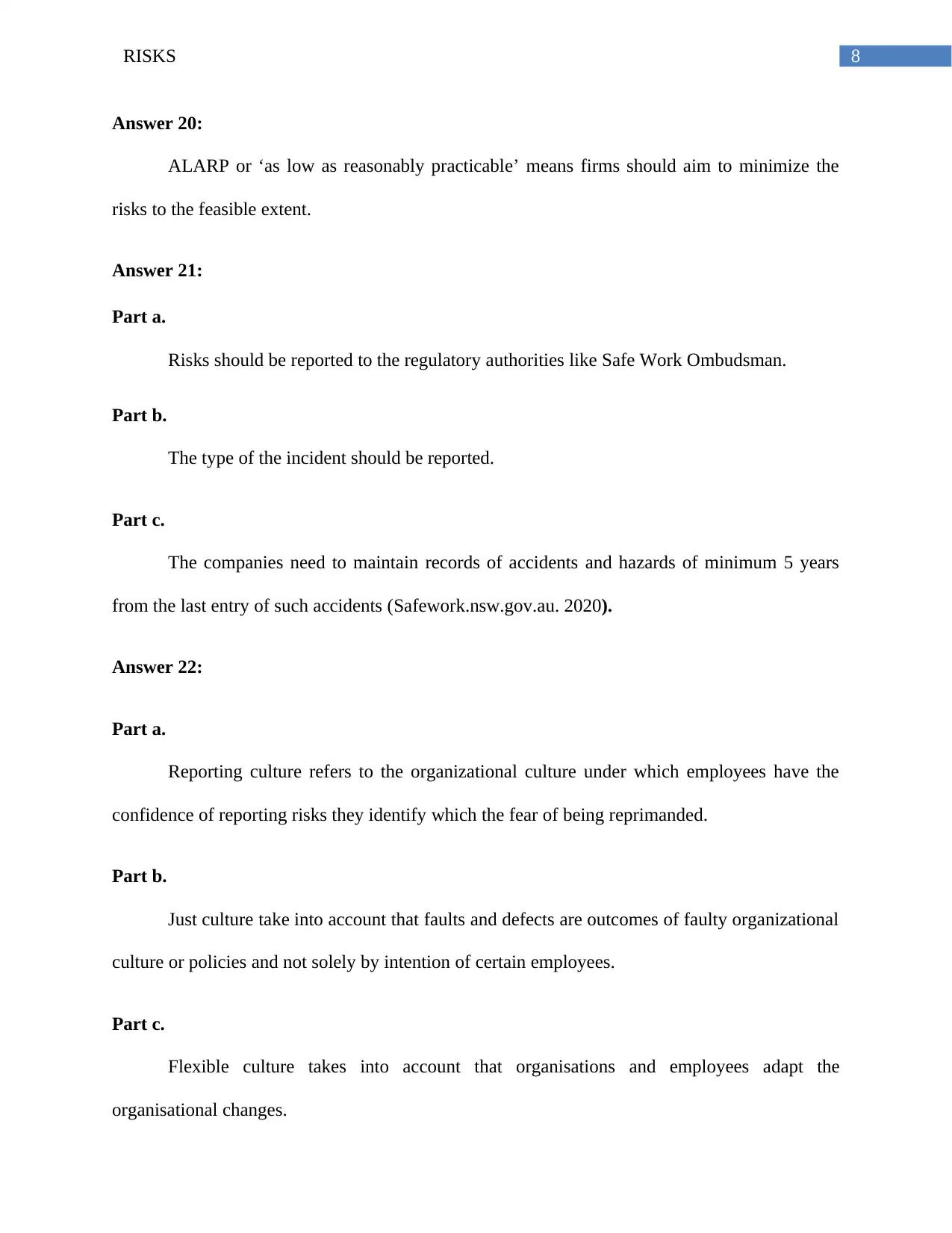
8RISKS
Answer 20:
ALARP or ‘as low as reasonably practicable’ means firms should aim to minimize the
risks to the feasible extent.
Answer 21:
Part a.
Risks should be reported to the regulatory authorities like Safe Work Ombudsman.
Part b.
The type of the incident should be reported.
Part c.
The companies need to maintain records of accidents and hazards of minimum 5 years
from the last entry of such accidents (Safework.nsw.gov.au. 2020).
Answer 22:
Part a.
Reporting culture refers to the organizational culture under which employees have the
confidence of reporting risks they identify which the fear of being reprimanded.
Part b.
Just culture take into account that faults and defects are outcomes of faulty organizational
culture or policies and not solely by intention of certain employees.
Part c.
Flexible culture takes into account that organisations and employees adapt the
organisational changes.
Answer 20:
ALARP or ‘as low as reasonably practicable’ means firms should aim to minimize the
risks to the feasible extent.
Answer 21:
Part a.
Risks should be reported to the regulatory authorities like Safe Work Ombudsman.
Part b.
The type of the incident should be reported.
Part c.
The companies need to maintain records of accidents and hazards of minimum 5 years
from the last entry of such accidents (Safework.nsw.gov.au. 2020).
Answer 22:
Part a.
Reporting culture refers to the organizational culture under which employees have the
confidence of reporting risks they identify which the fear of being reprimanded.
Part b.
Just culture take into account that faults and defects are outcomes of faulty organizational
culture or policies and not solely by intention of certain employees.
Part c.
Flexible culture takes into account that organisations and employees adapt the
organisational changes.
⊘ This is a preview!⊘
Do you want full access?
Subscribe today to unlock all pages.

Trusted by 1+ million students worldwide
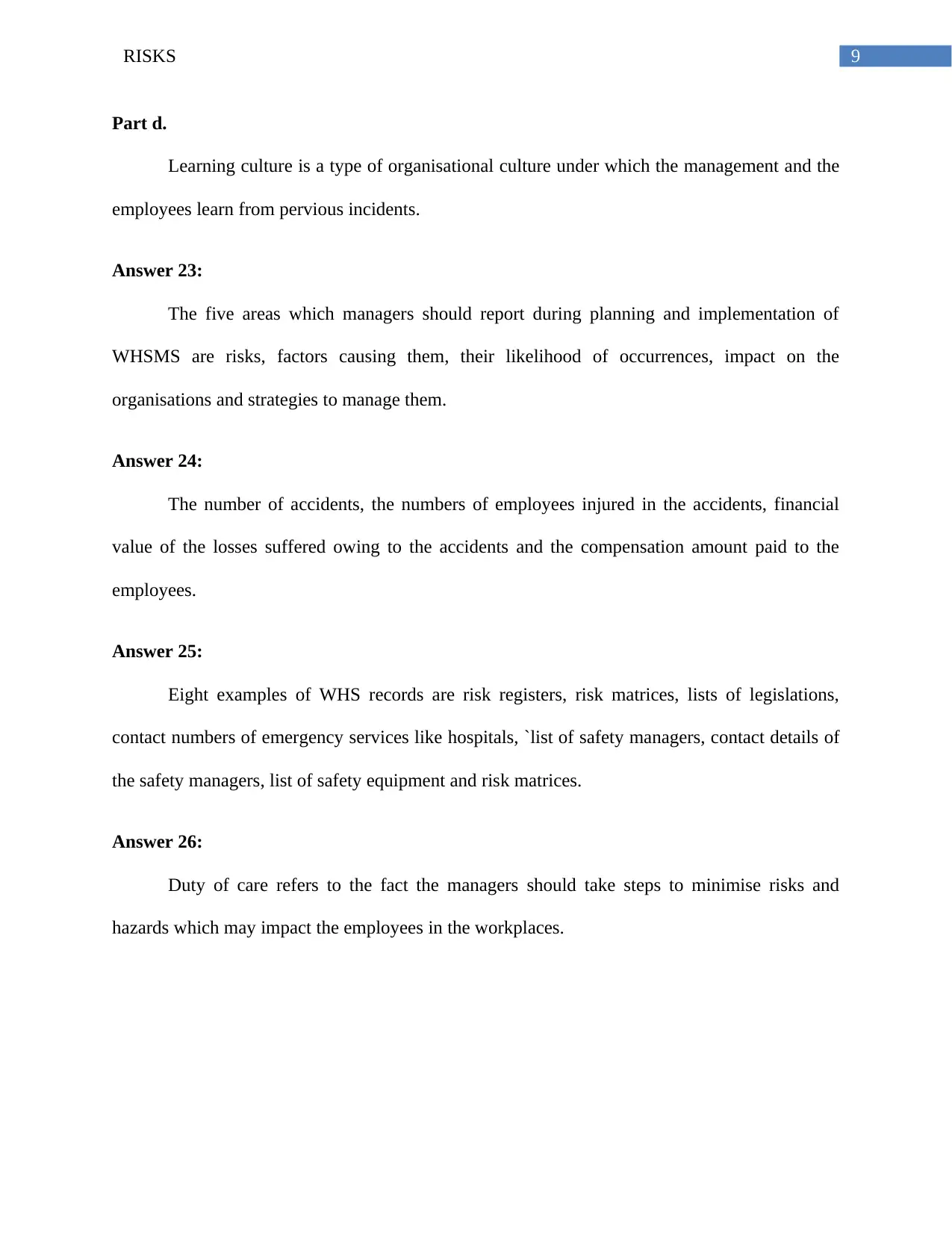
9RISKS
Part d.
Learning culture is a type of organisational culture under which the management and the
employees learn from pervious incidents.
Answer 23:
The five areas which managers should report during planning and implementation of
WHSMS are risks, factors causing them, their likelihood of occurrences, impact on the
organisations and strategies to manage them.
Answer 24:
The number of accidents, the numbers of employees injured in the accidents, financial
value of the losses suffered owing to the accidents and the compensation amount paid to the
employees.
Answer 25:
Eight examples of WHS records are risk registers, risk matrices, lists of legislations,
contact numbers of emergency services like hospitals, `list of safety managers, contact details of
the safety managers, list of safety equipment and risk matrices.
Answer 26:
Duty of care refers to the fact the managers should take steps to minimise risks and
hazards which may impact the employees in the workplaces.
Part d.
Learning culture is a type of organisational culture under which the management and the
employees learn from pervious incidents.
Answer 23:
The five areas which managers should report during planning and implementation of
WHSMS are risks, factors causing them, their likelihood of occurrences, impact on the
organisations and strategies to manage them.
Answer 24:
The number of accidents, the numbers of employees injured in the accidents, financial
value of the losses suffered owing to the accidents and the compensation amount paid to the
employees.
Answer 25:
Eight examples of WHS records are risk registers, risk matrices, lists of legislations,
contact numbers of emergency services like hospitals, `list of safety managers, contact details of
the safety managers, list of safety equipment and risk matrices.
Answer 26:
Duty of care refers to the fact the managers should take steps to minimise risks and
hazards which may impact the employees in the workplaces.
Paraphrase This Document
Need a fresh take? Get an instant paraphrase of this document with our AI Paraphraser
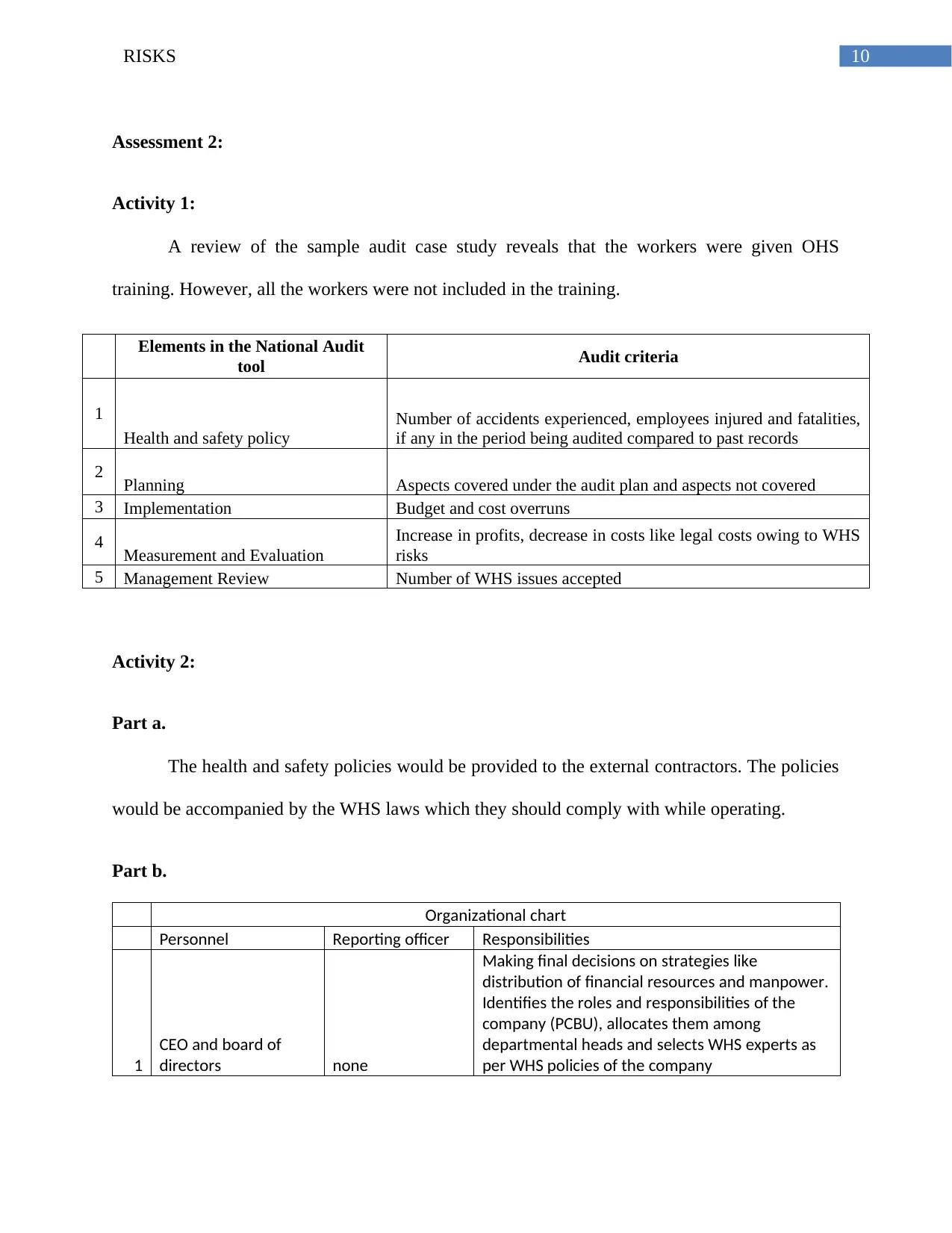
10RISKS
Assessment 2:
Activity 1:
A review of the sample audit case study reveals that the workers were given OHS
training. However, all the workers were not included in the training.
Elements in the National Audit
tool Audit criteria
1
Health and safety policy
Number of accidents experienced, employees injured and fatalities,
if any in the period being audited compared to past records
2 Planning Aspects covered under the audit plan and aspects not covered
3 Implementation Budget and cost overruns
4 Measurement and Evaluation
Increase in profits, decrease in costs like legal costs owing to WHS
risks
5 Management Review Number of WHS issues accepted
Activity 2:
Part a.
The health and safety policies would be provided to the external contractors. The policies
would be accompanied by the WHS laws which they should comply with while operating.
Part b.
Organizational chart
Personnel Reporting officer Responsibilities
1
CEO and board of
directors none
Making final decisions on strategies like
distribution of financial resources and manpower.
Identifies the roles and responsibilities of the
company (PCBU), allocates them among
departmental heads and selects WHS experts as
per WHS policies of the company
Assessment 2:
Activity 1:
A review of the sample audit case study reveals that the workers were given OHS
training. However, all the workers were not included in the training.
Elements in the National Audit
tool Audit criteria
1
Health and safety policy
Number of accidents experienced, employees injured and fatalities,
if any in the period being audited compared to past records
2 Planning Aspects covered under the audit plan and aspects not covered
3 Implementation Budget and cost overruns
4 Measurement and Evaluation
Increase in profits, decrease in costs like legal costs owing to WHS
risks
5 Management Review Number of WHS issues accepted
Activity 2:
Part a.
The health and safety policies would be provided to the external contractors. The policies
would be accompanied by the WHS laws which they should comply with while operating.
Part b.
Organizational chart
Personnel Reporting officer Responsibilities
1
CEO and board of
directors none
Making final decisions on strategies like
distribution of financial resources and manpower.
Identifies the roles and responsibilities of the
company (PCBU), allocates them among
departmental heads and selects WHS experts as
per WHS policies of the company
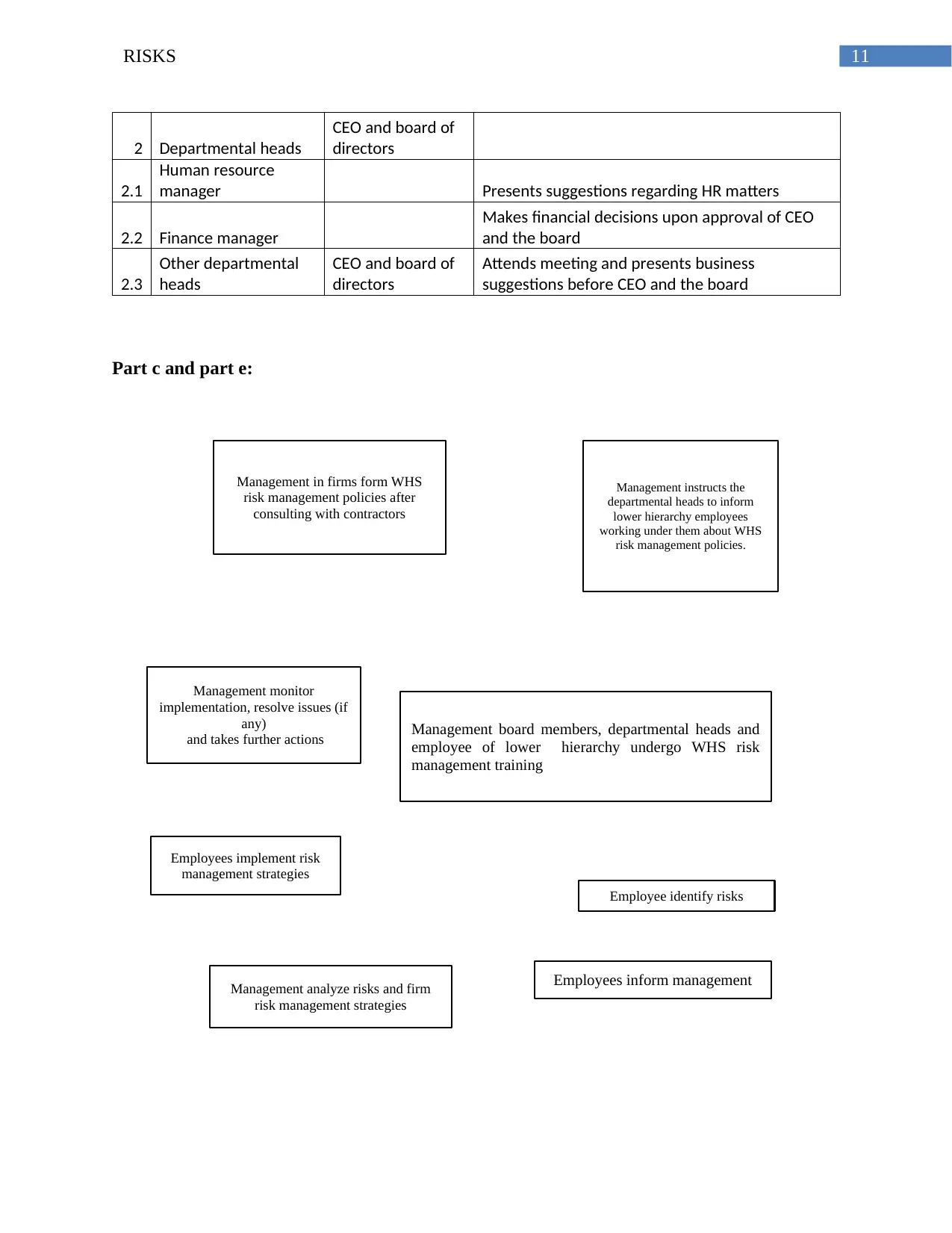
11RISKS
Management in firms form WHS
risk management policies after
consulting with contractors
Management instructs the
departmental heads to inform
lower hierarchy employees
working under them about WHS
risk management policies.
Management board members, departmental heads and
employee of lower hierarchy undergo WHS risk
management training
Employee identify risks
Employees inform management
Management analyze risks and firm
risk management strategies
Employees implement risk
management strategies
Management monitor
implementation, resolve issues (if
any)
and takes further actions
2 Departmental heads
CEO and board of
directors
2.1
Human resource
manager Presents suggestions regarding HR matters
2.2 Finance manager
Makes financial decisions upon approval of CEO
and the board
2.3
Other departmental
heads
CEO and board of
directors
Attends meeting and presents business
suggestions before CEO and the board
Part c and part e:
Management in firms form WHS
risk management policies after
consulting with contractors
Management instructs the
departmental heads to inform
lower hierarchy employees
working under them about WHS
risk management policies.
Management board members, departmental heads and
employee of lower hierarchy undergo WHS risk
management training
Employee identify risks
Employees inform management
Management analyze risks and firm
risk management strategies
Employees implement risk
management strategies
Management monitor
implementation, resolve issues (if
any)
and takes further actions
2 Departmental heads
CEO and board of
directors
2.1
Human resource
manager Presents suggestions regarding HR matters
2.2 Finance manager
Makes financial decisions upon approval of CEO
and the board
2.3
Other departmental
heads
CEO and board of
directors
Attends meeting and presents business
suggestions before CEO and the board
Part c and part e:
⊘ This is a preview!⊘
Do you want full access?
Subscribe today to unlock all pages.

Trusted by 1+ million students worldwide
1 out of 27
Related Documents
Your All-in-One AI-Powered Toolkit for Academic Success.
+13062052269
info@desklib.com
Available 24*7 on WhatsApp / Email
![[object Object]](/_next/static/media/star-bottom.7253800d.svg)
Unlock your academic potential
Copyright © 2020–2025 A2Z Services. All Rights Reserved. Developed and managed by ZUCOL.




